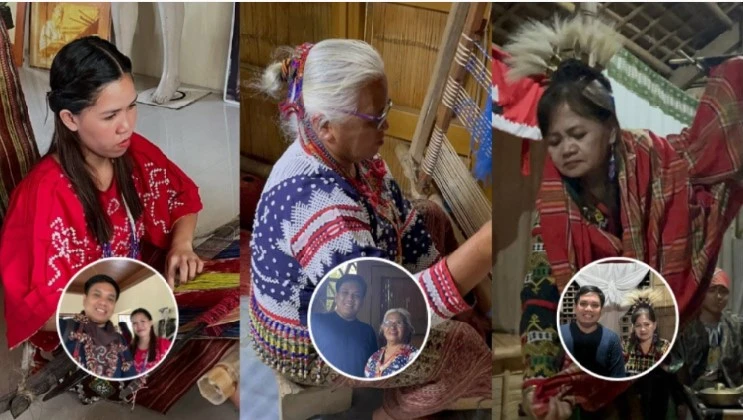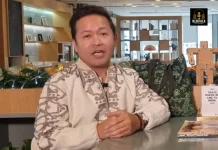
From Davao del Sur to South Cotabato, Day 3 of our journey was a celebration of heritage, artistry, and community. Each stop offered a unique cultural immersion, giving us a deeper glimpse into the soul of Mindanao.
This meaningful experience was part of the five-day Marketing Enhancement Program (MEP) organized by the Tourism Promotions Board Philippines (TPB), an attached agency of our country’s Department of Tourism.
Designed to highlight the beauty and diversity of the Philippines, the program shines a spotlight on both iconic destinations and hidden local gems. But more than just promoting tourism, it champions cultural preservation and community empowerment, supporting entrepreneurs, artisans, and tradition bearers through strategic marketing, storytelling, and sustainable tourism initiatives.
This program is perfect for cultural tours in the Davao and SOCCSKSARGEN (South Cotabato, Cotabato, Sultan Kudarat, Sarangani, and General Santos City) regions, home to a rich diversity of ethnolinguistic groups dedicated to preserving their arts and traditions. Though these groups share common threads, each boasts its own distinct identity and cultural heritage.
Let me take you through the communities and places we visited, where we experienced the warmth and vibrancy of these incredible regions.
Check out all the spots we explored in Davao City and Davao del Sur in Day 1 and Day 2 here:
Day 1: 24 Hours in Davao City: A Day of Culture, Cuisine, and Scenic Views | Atom Pornel
Welcome to Day 3—filled with discoveries and unforgettable experiences!
Salinta Monon Weaving Center
After breakfast and check-out from the Big 8 Corporate Hotel in Digos City, our delegation headed to the Salinta Monon Weaving Center in Bansalan.
Originally scheduled for Day 2, this visit was moved to Day 3 due to last-minute changes and unavoidable circumstances. Nevertheless, we were eager to experience the weaving center, named in honor of the late Salinta Monon, a renowned Bagobo Tagabawa master weaver who dedicated her life to preserving the inabal weaving tradition of her people.
In 1998, Salinta Monon was declared a Manlilikha ng Bayan (National Living Treasure), the highest recognition from the Philippine government for individuals who practice and preserve traditional art forms. For her, this honor was bestowed for her exceptional skill in weaving inabal, a fabric made from abaca fiber.
I was privileged to meet Salinta’s granddaughter, Lovelove, 27, who now carries on her grandmother’s legacy and keeps their weaving tradition alive. She shared that she began weaving at the age of 14.
“Pinagpatuloy ko po ang paghahabi ng abaka para hindi mawala. Dahil ito lang po ang naiwang pamana ni Lola sa amin, ang paghahabi ng abaka (I continued weaving abaca so that it won’t disappear. This is the only heritage our grandmother left us—abaca weaving),” she said.
She also expressed her desire to share her knowledge of traditional Bagobo weaving with the younger generation.
“Gusto ko rin po ito ipasa sa mga kabataan na tulad ko para hindi po mawala ang paghahabi (I also want to pass this on to the youth like me, so the weaving tradition won’t be lost),” the Bagobo weaver shared.
Lovelove emphasized that weaving is not just a skill, but something that requires full focus and heartfelt dedication.
“Dapat po naka-concentrate ang puso at isipan mo sa paghahabi. Kailangang naka-focus ang isipan mo para makuha mo po ’yong design (Your heart and mind must be fully focused on weaving. You need to concentrate so you can understand the design),” she noted.
“Pag hindi ka interesado, hindi ka matututo. Kailangan galing sa puso mo (If you’re not interested, you won’t learn. It has to come from your heart),” Lovelove concluded.
She also demonstrated how to weave abaca manually, a process that truly requires talent, patience, and a labor of love.
Before we left for our next destination, each of us received an authentic tangkulo—a traditional headdress of the Bagobo, traditionally worn by men of noble status. For us non-Bagobos, it can be worn as a scarf.
BATAFAMA (Bagobo Tagabawa Farmers Association)
We then made our way to BATAFAMA—the Bagobo Tagabawa Farmers Association Center—still located in Bansalan, Davao del Sur. This is where local farmers bring, dry, and process their coffee beans, renowned for their rich flavor and aroma.
It felt like an extension of our visit to the Coffee Museum on Day 2 at the Davao del Sur State College.
While my tour companions lined up for free coffee and browsed local coffee products, I was content watching the sorters at work. They carefully examined and sorted each coffee bean by hand, separating the high-quality ones from those less ideal.
That’s where I met Josephine Esteban, a coffee and cacao farmer who was serving as a bean sorter that day. Despite her busy workload, she graciously took the time to answer all my questions.
I learned that the cooperative operates through a beautiful mix of bayanihan and volunteerism—members help one another throughout the harvesting and selling process, ensuring that everyone earns a living together.
“Hindi naman ako talaga totally sorter. Nasa education committe po ako. [Ang ginagawa namin] bale tulong na rin (I’m not really a full-time sorter. I’m actually part of the education committee. What I’m doing is more of helping out),” Esteban explained.
She pointed out that while the demand for coffee is huge, they’re still unable to meet it fully.
“Kasi tons, tons na [ang demand]. Hindi pa kaya. Hindi pa lahat ng members ay productive ang kape. Katulad sa akin, hindi pa gaanong productive ang kape ko (The demand is already in tons—we just can’t keep up yet. Not all of our members have productive coffee farms. Mine, for example, isn’t producing that much yet),” she admitted.
She also opened up about the challenges they face as coffee farmers.
“Pag nagtamin kasi kami 18 months bago maging productive. Every three months kailangan mo talaga silang abonohan. Tapos every 15 days kailangan mo sila spray-an (When we plant, it takes about 18 months before the trees become productive. Every three months, we have to apply fertilizer, and every 15 days, we need to spray them),” Esteban shared.
Despite the hard work, she said they’re still able to earn through BATAFAMA.
“Ok naman. Tulong na rin. Medyo mababa [pa sa ngayon], at least meron. Nagtutulungan [kami] (It’s still a form of help. The income may be low for now, but at least there’s something. We help each other out),” she happily added.
Before we left, I felt the joyful atmosphere inside the small hall as my companions eagerly bought up their coffee products, bringing smiles to the farmers and a warm end to our visit.
As for the less ideal beans, they don’t go to waste—some traders and coffee shop owners still purchase them for their businesses.
Quick Stop at Camp Sabros
We made a quick stop at Camp Sabros in Kapatagan, Digos City. While others took water breaks, I went searching for an electric outlet to charge my phone. Because from here, it would be a two-hour drive to reach General Santos City in South Cotabato.
Camp Sabros looked familiar—I felt like I had seen it before, though I couldn’t quite remember if it was from a travel vlog or a TV show.
I couldn’t help but draw a comparison—this place felt like Davao del Sur’s version of Baguio City. With its towering pine trees and cool climate, it’s the perfect setting for the many coffee and vegetable farms scattered throughout the area.
With only a short time to explore, I made the most of our stop by taking as many photos as I could, especially from the view deck, where Mt. Apo is usually visible on clear days.
Unfortunately, the cool and cloudy weather kept Mt. Apo hidden from view. When we arrived at Camp Sabros, the majestic peak was completely cloaked in clouds. It felt as though the mountain was being shy, refusing to reveal itself.
But that only gives me one more reason to return. Yes—I need to come back.
Quick Lunch in General Santos City
It was already past 3 PM when we arrived in General Santos City, and our first order of business was to grab a quick lunch, especially since it would take another hour or two to reach the town of Polomolok.
Our delegation dined at ABIS Resto Grill, where we were treated to a spread of pork barbecue, pinakbet, tinolang halaan, and the city’s famous dish—kinilaw na tuna.
It was a quick yet enjoyable meal, filled with good food and light conversations.
As we returned to our van, one of our guides surprised us with a sweet treat: mango graham ice cream for everyone.
Fu Yabing Weaving Center in Polomolok
We had an enjoyable ride to Polomolok — at least, I did. Having grown up seeing rice fields during my travels from Cavite to Manila, and to Laguna, Bulacan, or Mindoro, it was refreshing to experience the vast pineapple plantations of South Cotabato. Although there are pineapple farms in Tagaytay, the ones in South Cotabato are much larger and more expansive.
Plus, I finally got to see Mt. Matutum, the highest peak in the province. We even decided to stop before reaching the Blaan community to capture the beauty of this active stratovolcano in photos.
Since the community was just a short walk away, Ms. Tina of TBP and I took a few steps to reach it, where we were warmly welcomed by the Blaan people. They even performed their traditional dance for us before guiding us to the Fu Yabing Weaving Center.
This weaving center was named after the Blaan master weaver Yabing Masalon Dulo, a Gawad sa Manlilikha ng Bayan awardee. She passed away in 2021 at the age of 106, and the weaving center and museum were built in her honor.
Fu Yabing’s legacy is now carried on by her only daughter, Lamina Dulo Gulili, who continues the art of weaving their traditional textile called tabih.
During our brief conversation, she shared that the skirt she was wearing that day was over 100 years old. Made of tabih, it was woven by her late mother when she was still very young.
As usual, I had to pick up a few souvenir items and snap as many photos as I could before we left.
Lake Sebu School of Living Traditions in Lake Sebu, South Cotabato
After a drive of about an hour from the Blaan community in Polomolok, we arrived at the School of Living Traditions (SLT) of the T’boli. We were now in Lake Sebu, renowned for its scenic lake and the intricate t’nalak textile.
I’d say the SLT is quite accessible, perched on a slope just beside the main road. As we ascended the stairs from the highway, we were welcomed by the festive sounds of gongs, drums, and k’lintang.
And lo and behold, there it was—the SLT I had only ever seen in documentaries and travel vlogs, now right before my eyes for the very first time.
(Fun fact: Miss Universe 2018 Catriona Gray featured this place in her “This is Philippines” series for her national costume.)
READ: Catriona Gray champions Filipino artistry in Miss Universe pageant
From what I observed, the ground floor housed the shop, restrooms, living quarters, and an open dining area. The second floor was where their homestay and learning hall were located.
T’boli cultural worker Bo’i Maria “Oyog” Todi runs the SLT. She welcomed us with a dinner featuring their traditional dishes. Grilled tilapia from Lake Sebu and grilled eggplant quickly became my instant favorites.
After our dinner, they introduced us to the beauty of T’boli culture, courtesy of the Helobung Community Dance Troupe, composed entirely of T’boli artisans from Lake Sebu.
One of their members is Bo’i Rosie Godwino Sula — an epic chanter, musician, dancer, and teacher. She is the youngest recipient of the Gawad sa Manlilikha ng Bayan award, recognized for serving as her people’s living archive and dedicating her life to preserving their rich oral traditions.
Of course, I didn’t miss the chance to have my picture taken with her!
We were also welcomed into their world of music and movement, as the group introduced us to their traditional instruments and graceful dances.
Before heading to the resort, I made sure to pick up some souvenirs to remember the whole experience.
Dolores Lake Resort
Our last stop on Day 3 was Dolores Lake Resort, a serene spa retreat nestled in Sitio Tokufol, Barangay Poblacion, Lake Sebu.
I was assigned a lovely room on the first floor—though interestingly, I had to go down to reach it. That’s because the front desk, which is level with the street, is actually located on the third floor. Since the resort is built on a slope, the first floor faces the lower side and overlooks the renowned lake.
Just to clarify, this isn’t a complaint—I actually enjoyed the up-and-down walk as a good decent workout. Yes!
Plus, I had a spacious room all to myself, complete with two queen-size beds, a large bathroom, and a fresh supply of linens. The staff were also incredibly warm and welcoming, despite our late check-in.
By 10 PM, we were all in our respective rooms, recharging for the next day’s full and busy schedule.
And that’s how our long Day 3 came to a close! A huge thanks to the amazing TPB team, our excellent tour guides and drivers, and everyone who helped make our journey from Davao del Sur to South Cotabato safe and unforgettable.
Stay tuned for Day 4 of our CBT adventure, which took us to the land—and waters—of the Dreamweavers: Lake Sebu, South Cotabato. Catch it soon here on GoodNewsPilipinas.com!
Join our vibrant Good News Pilipinas community, where we celebrate the achievements of the Philippines and Filipinos worldwide! As the Philippines’ No. 1 Website for Good News and proud winners of the Gold Anvil Award and Lasallian Scholarum Award, we invite you to connect, engage, and share your inspiring stories with us. Together, let’s shine a spotlight on the stories that make every Filipino proud. Follow us on all platforms through our LinkTree. Let’s spread good news and positivity, one story at a time!










